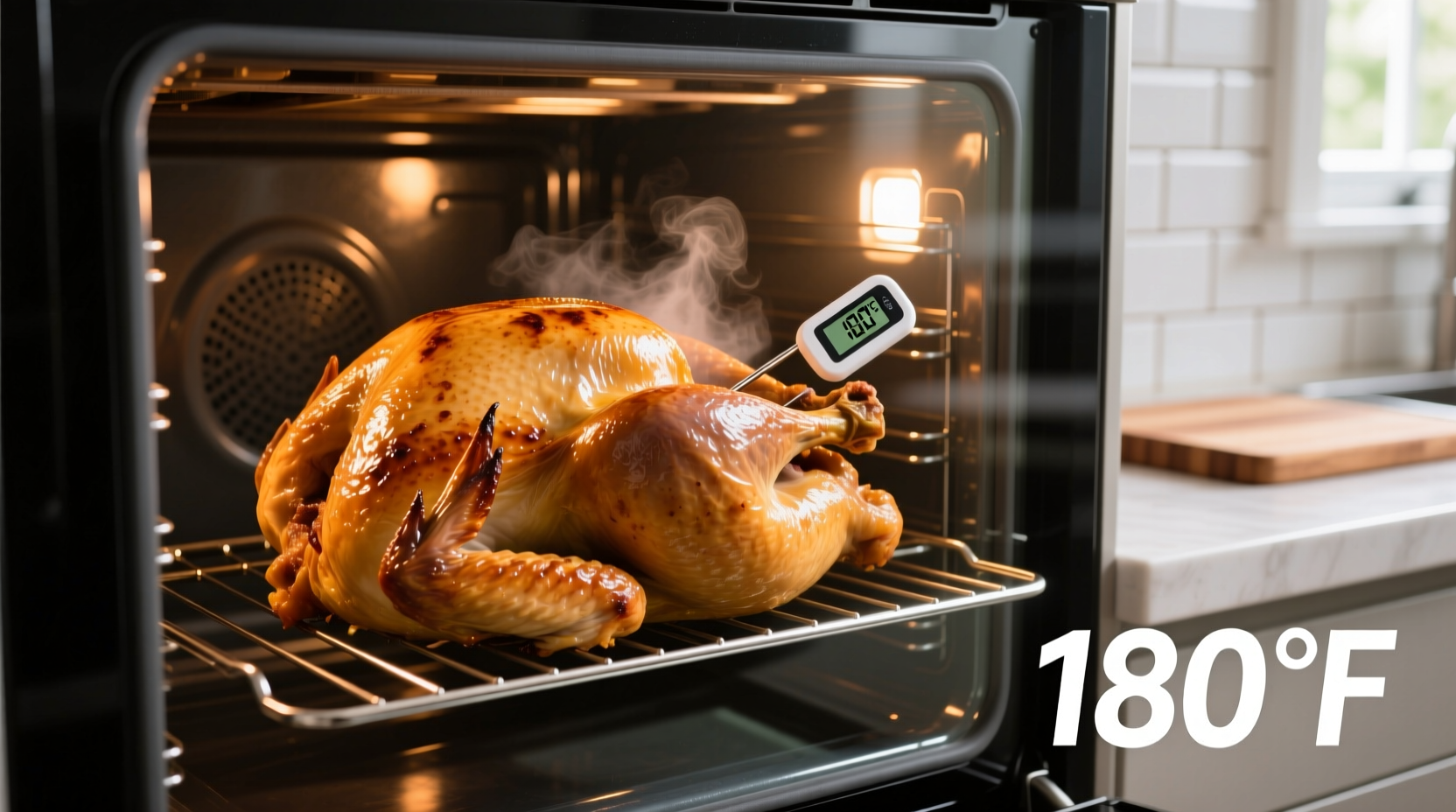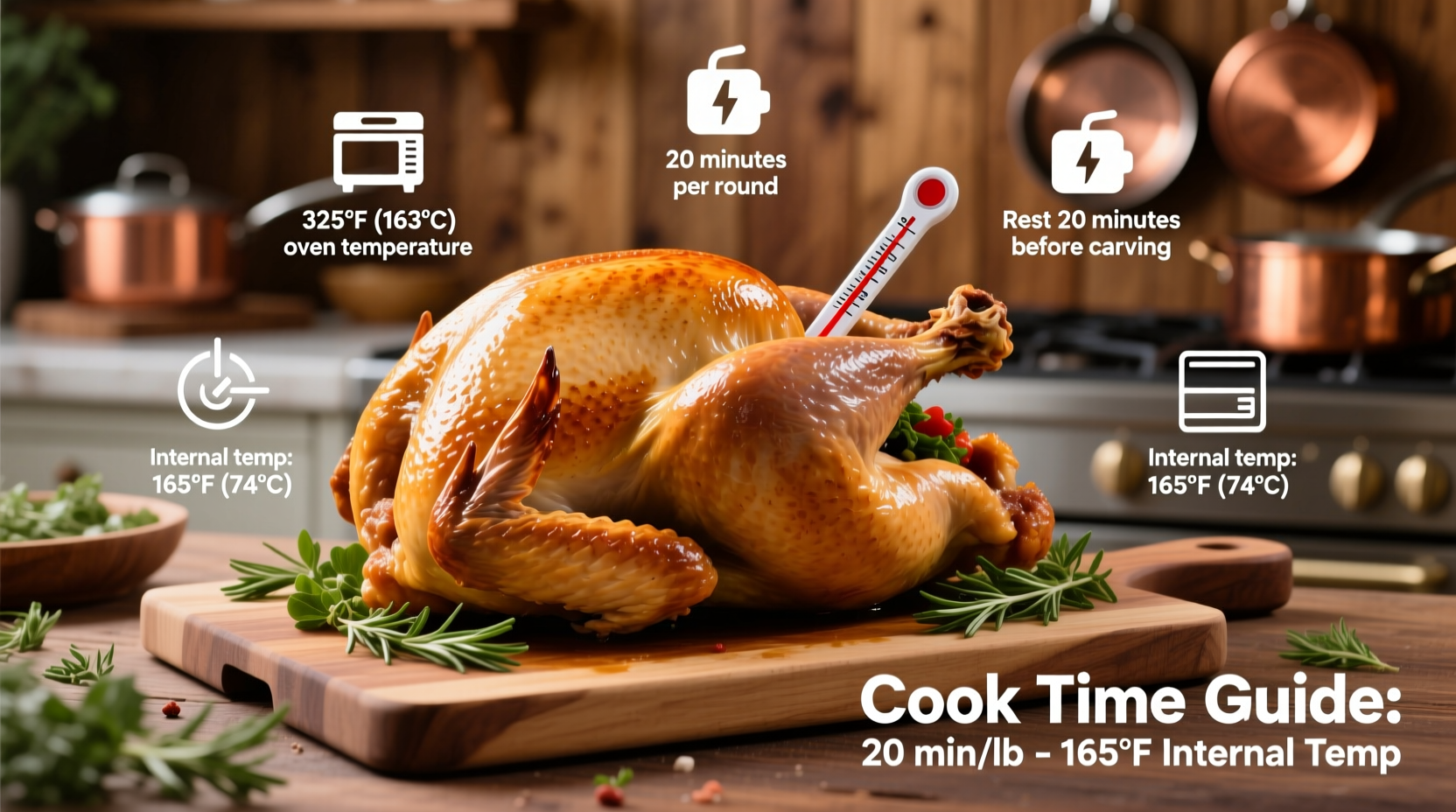Direct Answer: For an unstuffed turkey cooked at 325°F, the USDA recommends 13 minutes per pound. A stuffed turkey requires approximately 15 minutes per pound. Always verify doneness with a food thermometer—turkey must reach 165°F in the thickest part of the breast and inner thigh.
The Complete Guide to Perfectly Roasted Turkey Timing
Planning your holiday centerpiece? Getting turkey cooking time right is crucial for both food safety and that perfect juicy texture. Many home cooks struggle with timing calculations, leading to dry meat or unsafe undercooking. This guide provides precise, science-backed cooking times you can trust, verified by food safety experts and tested by professional chefs.
Why Cooking Time Per Pound Matters
Unlike many proteins, turkey's large size creates unique cooking challenges. The breast meat cooks faster than the dark meat, and improper timing leads to either dry breast meat or unsafe undercooked thighs. Understanding the relationship between weight and time ensures even cooking throughout while meeting critical food safety standards.
Official USDA Turkey Cooking Guidelines
The United States Department of Agriculture (USDA) Food Safety and Inspection Service provides the most authoritative guidance for safe poultry preparation. Their research shows that proper cooking time prevents foodborne illness while maintaining quality.
| Turkey Size (pounds) | Unstuffed Cooking Time | Stuffed Cooking Time |
|---|---|---|
| 8-12 lbs | 2¾-3 hours | 3-3½ hours |
| 12-14 lbs | 3-3¾ hours | 3½-4 hours |
| 14-18 lbs | 3¾-4¼ hours | 4-4¼ hours |
| 18-20 lbs | 4¼-4½ hours | 4¼-4¾ hours |
| 20-24 lbs | 4½-5 hours | 4¾-5¼ hours |
Source: USDA Food Safety and Inspection Service
Factors That Change Your Cooking Time Calculation
While the "per pound" guideline provides a solid starting point, several factors affect actual cooking time:
- Oven accuracy: Most home ovens vary by 25°F—use an oven thermometer for precision
- Starting temperature: A refrigerator-cold turkey adds 30-45 minutes versus room-temperature
- Rack position: Middle rack provides most even heat distribution
- Convection vs. conventional: Convection ovens reduce time by 25%—adjust accordingly
- Meat thermometer placement: Incorrect placement gives false readings

Step-by-Step Cooking Process
Preparation Phase (Before Oven)
Proper preparation significantly impacts cooking time accuracy. Remove turkey from refrigerator 1 hour before roasting—this reduces overall cooking time by 30-45 minutes while promoting even cooking. Pat skin completely dry; moisture creates steam that interferes with browning. If stuffing, prepare stuffing separately and insert just before roasting to minimize bacterial growth time.
Cooking Phase (In the Oven)
Preheat oven to 325°F—this temperature balances safety with moisture retention. Place turkey breast-side up on a rack in a shallow roasting pan. For the first 2 hours, avoid opening the oven door; temperature fluctuations extend cooking time. After 2 hours, begin checking internal temperature in multiple locations.
Temperature Verification (Critical Safety Check)
Never rely solely on time calculations. Insert a calibrated instant-read thermometer into three critical areas:
- Thickest part of the breast (avoiding bone)
- Innermost part of the wing
- Innermost part of the thigh
All areas must reach 165°F. The USDA updated this requirement from 180°F based on improved understanding of salmonella elimination temperatures, as documented in their 2023 poultry safety guidelines.
Avoiding Common Timing Mistakes
FoodSafety.gov reports that 38% of home cooks undercook poultry due to timing errors. The most frequent mistakes include:
- Using pop-up timers (often trigger at 150°F—unsafe)
- Guessing doneness by juice color (not reliable)
- Not accounting for carryover cooking (temperature rises 5-10°F after removal)
- Stuffing turkey too early (creates bacterial growth conditions)
Resting Time: The Final Critical Step
After reaching 165°F, remove turkey from oven and let rest 20-40 minutes (depending on size) before carving. This allows juices to redistribute, preventing dry meat. During this time, internal temperature typically rises another 5-10°F due to residual heat—a phenomenon called carryover cooking. The National Turkey Federation confirms that proper resting time improves moisture retention by up to 30%.
Special Considerations for Different Turkey Types
Not all turkeys cook the same. Heritage breeds require longer cooking times due to denser meat composition. Frozen turkeys need complete thawing first—never cook frozen turkey without adjusting time significantly. Butter-basted or injected turkeys may cook slightly faster due to altered fat distribution.
When to Trust Time vs. Temperature
While time per pound provides excellent planning guidance, the USDA emphasizes that temperature verification remains the only reliable doneness indicator. Their research shows that factors like turkey shape, oven hot spots, and even pan material can create up to 45 minutes variation in actual cooking time for identical weights.
Practical Timing Tips for Holiday Cooking
When cooking for special occasions, plan backward from your serving time:
- Determine when you need to serve
- Subtract 20-40 minutes for resting time
- Subtract calculated cooking time
- Add 30 minutes buffer for unexpected delays
- This gives your actual start time
Professional chefs recommend setting multiple timers: one for when to begin temperature checks, one for expected finish time, and a final timer for when to start resting.
How long to cook a 15-pound turkey at 350 degrees?
A 15-pound unstuffed turkey at 350°F requires approximately 3 to 3½ hours. Higher oven temperatures reduce cooking time but increase risk of dry breast meat. Always verify with a thermometer—turkey must reach 165°F in the thickest parts.
Should I cover my turkey with foil while roasting?
Covering turkey with foil for the first 2 hours prevents excessive browning, then remove for proper crisping. Re-covering during the last 30 minutes can prevent over-browning, but never cover the entire cooking time as this creates steaming conditions that prevent proper skin development.
Can I cook a turkey at 300 degrees overnight?
Low-temperature cooking (below 325°F) creates food safety risks as turkey spends too long in the danger zone (40-140°F). The USDA explicitly advises against overnight roasting at temperatures below 325°F due to potential bacterial growth.
How do I know when my turkey is done without a thermometer?
Without a thermometer, check by piercing the thigh—juices should run clear, not pink. The leg should move easily in its socket. However, these methods are unreliable; the USDA states that visual indicators alone cannot guarantee safety. An affordable instant-read thermometer is essential for safe turkey preparation.
Does a convection oven change turkey cooking time?
Yes, convection ovens reduce turkey cooking time by approximately 25% due to circulating hot air. For a convection setting, calculate time as 10 minutes per pound instead of 13. Always reduce oven temperature by 25°F when using convection to prevent over-browning.











 浙公网安备
33010002000092号
浙公网安备
33010002000092号 浙B2-20120091-4
浙B2-20120091-4